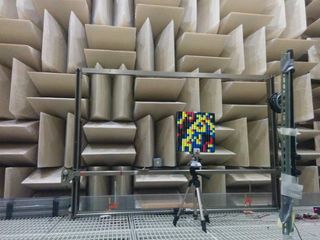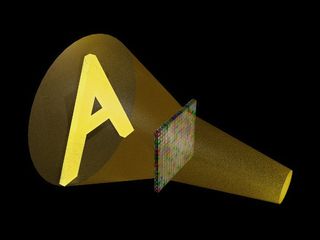
3D-printed bricks that look like Lego pieces could provide a simple, low-cost way of creating acoustic holograms — 3D shapes and structures made of sound — for applications as varied as entertainment, medicine or wireless charging, according to a recent study.
Anyone who's watched "Star Wars" will be familiar with the concept of an optical hologram — a 3D image that floats in midair — though real-life technology is significantly less advanced than what was portrayed on-screen.
Holograms are effectively a recording of a 3D light field that can project a reproduction of the original object when lit properly. (The term hologram can refer to both the recording medium and the resulting projection.) The hologram concept can be applied to sound waves to create acoustic holograms, though this field of research is still very new, according to the scientists who developed this new method. [10 Futuristic Technologies 'Star Trek' Fans Would Love to See]
Previous approaches have required complicated arrays of speakers and controlling electronic. But now, researchers have demonstrated how a wall of intricately designed plastic bricks can be used to bend sound waves from a single speaker into complex 3D shapes.

"What we've shown is that you can use carefully designed and engineered structures to create a very complicated sound field from a very simple source," said Steve Cummer, who led the research.
"This is a lot like a holographic sheet that you put in front of a light, and what gets transmitted is a much more complicated sound field," said Cummer, a professor of electrical and computer engineering at Duke University in North Carolina. "So, it doesn't require any extra sources — it's just an add-on to whatever sources you already have, and it's relatively easy to make," he told Live Science.
Building the "bricks"
The bricks are so-called metamaterials, a family of materials featuring specially engineered microstructures that result in unusual properties not found in nature. The team designed 12 different types of bricks that effectively slow down sound waves at different rates.
Sign up for the Live Science daily newsletter now
Get the world’s most fascinating discoveries delivered straight to your inbox.
These bricks are fabricated using a conventional 3D printer and act as the pixels of the hologram. A modified version of an algorithm for designing optical holograms was used to determine the configuration of bricks needed to reproduce the desired 3D sound field.
In a paper published Oct. 14 in the journal Scientific Reports, the researchers described using the approach to create a 256-pixel hologram that converted a uniform sound wave into a sound field in the shape of the letter A. The scientists created another hologram that acted as a holographic lens by focusing sound energy onto multiple circular spots of different sizes.
Cummer stressed that the research is exploratory at this stage. But Yangbo "Abel" Xie, a doctoral student in Cummer's laboratory and first author of the paper, said the approach has significant advantages over previous methods that relied on speaker arrays.
"[Other methods] consume a lot of power; they need fairly complicated controlling circuits and electronics," Xie told Live Science. "And since the system is more complicated, it tends to be more unstable. With our method, once you build the hologram, it will last a long time, be very stable and doesn't consume any electricity."
Xie added that one potential application for the technology is for audio speakers, and he said the university's commercialization office is actively looking for industrial partners to help develop the technology.
"Speakers don't just convey information on frequency and pitch; they also give you spatial information," he said. "If you have your iPhone playing back a cello suite, it sounds like a single speaker playing back a cello suite. One potential application is that we can use this hologram to reconstruct a better acoustic scene, where your sense of spatial information of sound is more real."
An innovative idea
Peer Fischer, a physical chemist at the Max Planck Institute for Intelligent Systems in Stuttgart, Germany, who was not involved with the research, said the new method looks promising. His group recently created acoustic holograms from ultrasonic waves using specially designed 3D-printed plastic blocks.
"This is particularly promising for long-wavelength, low-frequency acoustics, as it allows the elements of the hologram to be very compact," he told Live Science. "Their approach will enable exciting possibilities in shaping sound fields."
However, the researchers also hope to adapt their approach to manipulate ultrasonic waves. Ultrasound operates at much shorter wavelengths, so this means shrinking the bricks to one-one-hundredth their current size, Cummer said.
Cummer and his colleagues have collaborated with scientists at MIT to create early versions of millimeter-size bricks with even smaller internal features.
The researchers think this could lead to better ultrasound imaging devices.
Current systems use arrays of transducers — basically, loudspeakers — that produce precisely controlled sound waves, but the small wand needs to be hooked up to a large machine that houses the complex control system. A system using their approach could be much more compact, Xie said.
A number of startup companies are also working on using ultrasound to wirelessly charge phones, and Xie said their approach could drastically simplify the way these systems are controlled, too.
Original article on Live Science.


